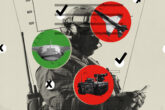April 30, 2020
When machine learning comes to nuclear communication systems
Nuclear deterrence depends on fragile, human perceptions of credibility.
As states armed with nuclear weapons turn to machine learning techniques to enhance their nuclear command, control, and communications (NC3) systems, the United States and its competitors should take care that these new tools do not inadvertently accelerate crisis instability or an arms race.
NC3 Systems and Credibility
Stability between competing nations largely relies on ascertaining the credibility of threats, capabilities, and decisions in order to decrease uncertainty and reduce the risk of conflict. Throughout the Cold War, NC3 systems served as mechanisms for signaling intent and capability, ensuring the credibility of deterrence postures, and decreasing the risk of nuclear war. In the early 21st century, technological developments such as machine learning techniques are introducing new dynamics and capabilities that increase uncertainty and lend to “strategic instability.”
Read the full article from C4ISRNET.
Learn more about the Artificial Intelligence and International Stability Project:

Artificial Intelligence and International Stability Project
Despite calls from prominent scientists to avoid militarizing AI, nation-states are already using AI and machine-learning tools for national security purposes. AI has the pote...
Read MoreMore from CNAS
-
Technology & National Security
Promethean RivalryExecutive Summary Just as nuclear weapons revolutionized 20th-century geopolitics, artificial intelligence (AI) is primed to transform 21st-century power dynamics—with world l...
By Bill Drexel
-
Defense / Technology & National Security
Safe and EffectiveThe promise of artificial intelligence (AI) and autonomy to change the character of war inches closer to reality...
By Josh Wallin
-
Technology & National Security
Catalyzing CrisisThe arrival of ChatGPT in November 2022 initiated both great excitement and fear around the world about the potential and risks of artificial intelligence (AI). In response, s...
By Bill Drexel & Caleb Withers
-
Technology & National Security
Obstacles and Opportunities for Transformative ChangeWatch:...
By Paul Scharre




